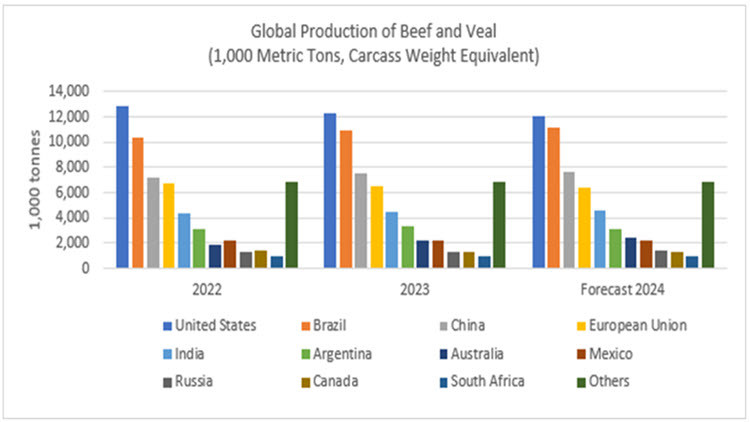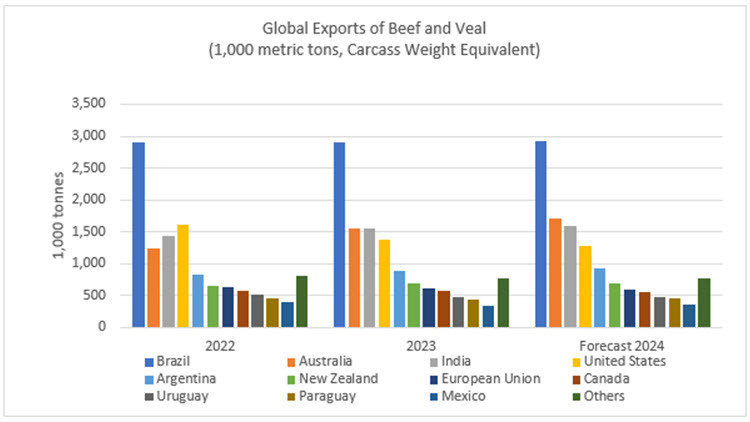Source: Government of Alberta
“Brazil has recently made the self-declaratory announcement that it was Foot-and-Mouth Disease (FMD) free without vaccination and will submit a request to the World Organization for Animal Health (WOAH) for recognition of this status,” says Ann Boyda, provincial livestock market analyst with the Alberta government. “Brazil is hopeful for WOAH approval by May 2025. This is an important step toward reaching the more remunerative markets of Japan and South Korea.”
Both Japan and South Korea are valuable beef markets for Alberta and retaining a preferred supplier position is important. Canadian beef exports to Japan were valued at $352 million in 2023, of which nearly $300 million was derived from Alberta exports. South Korea is a smaller trading market for Canada and Alberta, valued at $121.8 million and $105.4 million in 2023, respectively.
Brazil is a dominant player in beef trade, the largest exporting country and the second largest beef producer. United States Department of Agriculture (USDA) global beef and veal production projections for 2024 are 1.5% higher than 2023 levels at 60.4 million tonnes. The top 5 world beef producers are forecast to produce 41,967,000 tonnes of beef (69.5% of the world’s beef production) and include United States (U.S.), Brazil, China, European Union (EU) and India. U.S. volumes were forecast to decrease by 1.9%, whereas production increases are expected in Australia (7.7%), Brazil (2.4%), China (2.3%) and India (2.2%). Canada’s beef production is forecast at 1,305,000 tonnes, a 3.6% decrease from 2023 levels.
Figure 1. Global production of beef and veal

USDA also forecast global exports of beef and veal at 12,335,000 tonnes, an increase of 1.2% from 2023. Brazil remains the largest exporter (2,930,000 tonnes), followed by Australia (1,705,000 tonnes), U.S. (1,272,000 tonnes) and Argentina (920,000 tonnes). Canada’s beef exports for 2024 are forecast at 560,000 tonnes, representing a 2.1% decrease from 2023.
Figure 2. Global exports of beef and veal

Global beef and veal imports in 2024 are anticipated to remain relatively steady (10,399,000 tonnes), with the top importing countries being China (3,450,000 tonnes), followed by U.S. (1,894,000 tonnes), Japan (705,000 tonnes) and South Korea (585,000 tonnes). U.S. and United Kingdom are anticipated to increase imports by 12% and 2.9%, respectively.
Brazil has expanded its global beef footprint. It has strengthened its position in China, becoming China’s largest beef supplier. According to the Center for Advanced Studies on Applied Economics (CEPEA), year-to-date (January to April 2024) China has purchased 374.63 thousand tons of Brazilian beef and Hong Kong has purchased 40.21 thousand tons of Brazilian beef.
“China’s beef imports have trended upward over the last 3 years,” explains Boyda. “This implies that the Chinese consumer is developing a taste for beef, especially with access to lower value product. China has recently approved 38 Brazilian meat and poultry plants for export. CEPEA reports that there are now 144 authorized slaughterhouses in Brazil for export to China, with the majority owned by Brazilian JBS.
“Brazil’s beef industry is recognized as being efficient and competitive which has supported its export capacity. Brazil has been very effective in diversifying its export markets. Although China is its major export market, the United Arab Emirates is second, followed by U.S. and Hong Kong. Should Brazil obtain its FMD-free status, the higher value market opportunities of Japan and South Korea are attainable.”








